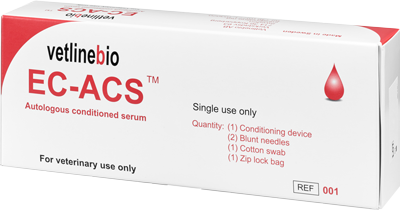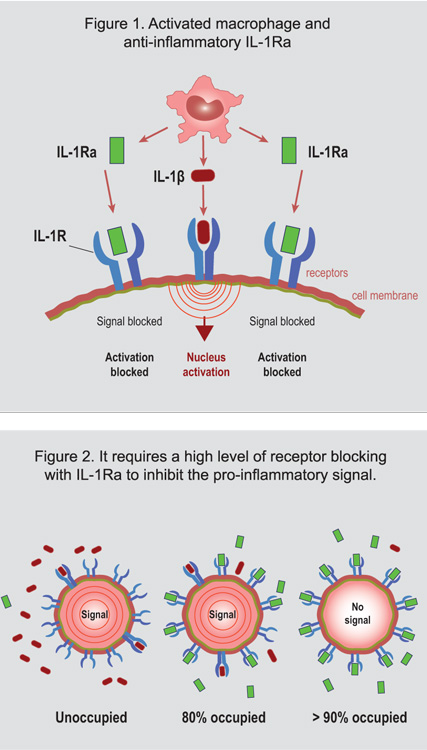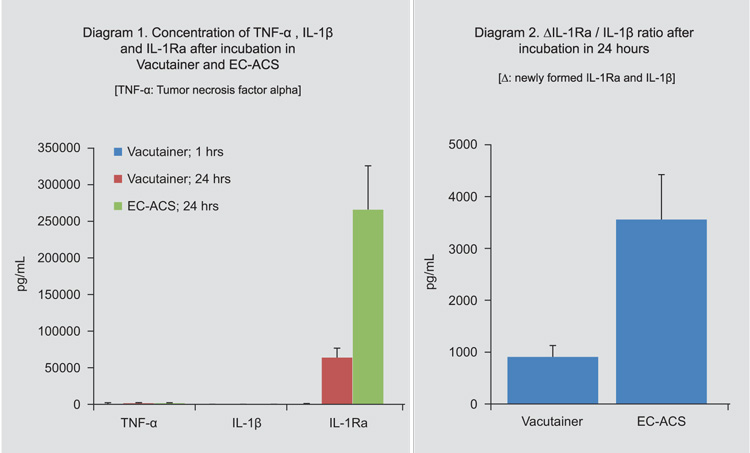 AN IMPROVED TREATMENT OF JOINT INFLAMMATION, by Vetlinebio.
AN IMPROVED TREATMENT OF JOINT INFLAMMATION, by Vetlinebio.
What is the Problem?
Osteoarthritis is a common cause of lameness in horses and dogs.
It is caused by an overproduction of inflammatory proteins, predominantly interleukin 1 beta (IL-1β). It results in inflammatory and degenerative changes in the joint.
What is EC-ACS™ for horses?
EC-ACS™ is a blood product containing concentrated amounts of an anti-inflammatory protein called interleukin-1 receptor antagonist protein (IL-1Ra). It is most commonly used to treat the early stages of osteoarthritis.
IL-1Ra counteracts the destructive effects of inflammatory proteins, such as IL-1β, within the inflamed joint. (Fig. 1,2) (1,2)

How do I get EC-ACS?
EC-ACS™ is produced by the horse, in effect the horse can treat its own problem. Blood is taken from the horse, the blood is “activated” under selected conditions to make IL-1Ra. The serum which now has high levels of the anti-inflammatory protein, is harvested for subsequent treatment.
What does EC-ACS™ therapy do for lameness in horses?
The IL-1Ra protein is injected into the affected joint. The serum with high concentration of anti-inflammatory proteins inhibits the inflammation that leads to cartilage damage and osteoarthritis.
EC-ACS™ may be used repeatedly without detrimental effects to the cartilage. If used early in joint disease, EC-ACS™ may prevent progression and development of osteoarthritis.
EC-ACS™: better quality, fewer injections, faster recovery?
EC-ACS™ results in a production of significantly higher concentrations of active inhibitors of the proteins causing the osteoarthritis. (Diagram 1, 2)
Other products have been shown to produce these on the same levels as common red cap tubes (vacutainer). (3, 4) The former use of specialised ACS containers have been questioned. (4)
The inhibitors, IL-1Ra, have a short half-life so current treatments may in fact have little effect even after several injections. EC-ACS overcomes this by generating much higher levels of the active ingredient, IL-1Ra. An additional benefit is that this may result in less injections and faster recovery.
EC-ACS™ and EquiChek?
In instances of high post-operative serum amyloid A (SAA), or in situations where there is a suspicion there may be inflammation, postponing blood collection for EC-ACS™ preparation until reaching normal levels of SAA may help ensure a higher quality of the EC-ACS™.
EquiChek™ does this simply and rapidly (see EquiChek™ instructions for details). If there are 3-4 lines to see on the test, go, if there are 1-2 lines, wait, and check the horse again within 24 -48 hours. For additional tests, contact your local supplier.

REFERENCES:
1. C.W. McIlwraith, Management of joint diseases in horses: Current and future prospects. Equine vet. Educ. (2015) 27 (7) 335-337. 2. Jacques C, Gosset M, Berenbaum F, Gabay C, The role of IL-1 and IL1Ra in joint inflammation and cartilage degradation. Vitam Horm. 2006;74:371-403. 3. T. H. Hraha, K. M. Doremus, C. W. McIlwraith and D. D. Frisbie, Autolgous conditioned serum: The comparative cytokine profiles of two commercial methods (IRAP and IRAP II) using equine blood. Equine vet. J. (2011) 43 (5) 516-521. 4. C. T. Fjordbakk, G. M. Johansen†, A. C. Løvås, K. L. Oppegård and A. K. Storset, Surgical stress influences cytokine content in Autologous Condtioned Serum, Equine vet J. (2015) 47 (2) 212-217.
For additional information about EC-ACS or its application, please contact Moira McCracken, Director of Veterinary Sales, at (800) 752-8538 or via email. [Click Here]
